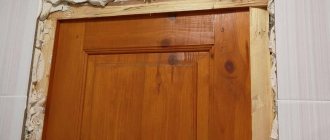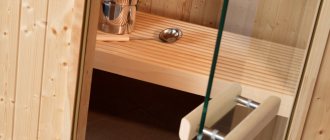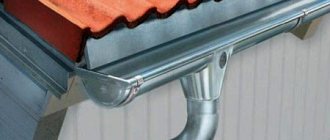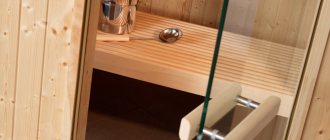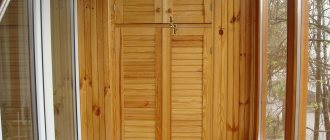Closer, Accessories
To protect the door from premature failure, closers are often used. These devices are designed to smoothly and accurately slam the door leaf. A specific model is selected based on many factors:
- temperature changes;
- expected load;
- the weight of the canvas itself;
- required level of reliability.
Often such mechanisms cost a lot, and if for external doors this is justified by the reliable service of purchased devices, then for internal doors or a summer house it is more economical to make a homemade closer.
How does the closer work?
A standard door closer is divided into three components:
- main fastening body;
- barbell;
- fastening element.
There is a spring inside the device body, which compresses when the door is opened. As soon as the canvas is released, it will begin to return to its original state. A special composition helps slow down this process and make it smooth - due to its viscosity, it prevents the door from abruptly slamming.
One of the internal mechanism options
The case has two compartments, in one of which the composition remains as long as the door is closed. When the composition changes, the oil flows into the second compartment, where the spring movement is inhibited.
The spring is closely connected to the rod - a movable element of the mechanism that connects the main body and an additional one - attached to the wall or door (depending on the model).
What functions should the slamming mechanism perform?
Before you make an automatic door closer with your own hands, you need to have an idea of what it should ultimately provide. The main function is shock absorption - preventing the door leaf from hitting the frame. Along with this, the following functionality is highlighted:
- adjustment - the ability to set the closing speed;
- attraction - if the closure is not tight, the mechanism will close the door itself;
- fixation - the ability to fix the closer in one position.
The last point is not mandatory for factory models either, so in the homemade version, any suitable objects are used as a stopper.
Its closing mechanism must attract and smoothly close the door. For these purposes, ready-made parts from cars or improvised means are used.
Magnet
A magnet is more of a kind of alternative to a door closer. Making such a mechanism with your own hands is as easy as shelling pears. To do this you will need a screwdriver, self-tapping screws, a chisel, a metal plate with holes and a magnet.
To ensure a tight rebate, it is recommended to install the parts almost flush. You can leave a small protrusion so that the magnet and metal can adhere to each other. First, outline the position of the elements. The magnet is attached to the frame, and the metal plate is attached to the door leaf in such a way that in the closed position they overlap each other. Using a chisel, scrape the coating to the required depth. Using self-tapping screws, fix both parts and check their operation.
Using ordinary available materials, you can make a door closer with your own hands. It can be used as a temporary device or you can completely stop with this choice.
Car door closers
The trunk of a car is an ideal example of using an automatic closer. Smooth opening, closing and shock absorption make this part a worthy alternative to factory models.
Fasteners are attached to the part. Depending on the design, these can be brackets of various types. With their help, the finished device is attached to the door and wall (or frame).
Springs from a car closer
The advantage of this method is the ability to fix the door leaf in the open position: other homemade closers acquire this function only with the help of additional devices.
You can get the part in your car, by asking friends or at the market. It is cheaper to buy a used working part than to purchase a factory model of the slamming mechanism.
The secret to securely attaching hinges
There is such an important point when using hinges - this is the reliability of fastening the doors. Without reliable fastening, the smooth fastening system will be unnecessary.
Hinge Cup Attachment
You can secure the hinge cup to the door using self-tapping screws, but there is a more reliable method of fastening using special spacer plugs and screws.
To install the plugs, you need to drill two holes with a diameter of 8 mm. Find out if such a service is provided in the place where you order drilling for awnings.
| Rice. 27-28. Drilling the facade under the hinge cup and spacer plugs |
| Rice. 29. Spacer plugs for attaching the hinge cup |
| Rice. 30. Installation diagram for a hinge with Expando spacer plugs |
Mounting the strike plate
The strike plate can be secured to the side wall using self-tapping screws, Euroscrews, and the most reliable way is with Euroscrews of smaller diameter through spacer plugs.
The structure of the chipboard is loose and a self-tapping screw or Euroscrew may eventually break out of the chipboard and you won’t be able to screw it back in, you’ll have to glue in the chips, re-drill, and then, it won’t last long, you’ll have to change the side wall. Only a bar for spacer plugs will ensure long-lasting and reliable fastening.
Drilling is done with a drill with a diameter of 5 mm, similar to drilling for Euro screws.
If you don’t have the time or extra money to improve your door design, you can make a door closer with your own hands. In this case, you can use the simplest items that you probably have in your pantry. Such a homemade mechanism will allow you to eliminate the problem of door knocking at minimal cost.
Rubber door closers
To make such a door closer with your own hands, the thrifty owner will not have to spend money. They can act as an attracting and shock-absorbing device;
- pieces of rubber;
- pears;
- hoses or tubes.
An example of pipes suitable for use
Located on the door leaf, these elements are easily deformed when the door is opened, but just as easily restore their shape, ensuring the door closes.
The advantage of this type is its cost, ease of installation, and the ability to regulate mechanical force. Rubber has different densities, which allows you to select the best options for a particular door. The only drawback is that it is not aesthetically pleasing, since a piece of rubber or a pear as a closer does not look very attractive. However, for storage rooms and other non-public premises this is the best option.
Springs as a slamming element
One of the simple and affordable ways is to install a spring as a closer. The advantages of this method include:
- ease of installation;
- availability;
- possibility of exposure regulation;
- relative aesthetics.
Springs have a number of characteristics, due to which the optimal option is selected. There is no clear formula for which spring to use for a door of a certain weight. Therefore, you will have to choose empirically.
Simple spring mechanism
Installation involves installing one end of the spring on the door leaf, and the other on the frame or wall.
Settings
Setting up a homemade mechanism is as follows:
- the speed of movement of the sash in a homemade product is regulated by changing the length of the elastic element (in spring structures) or the weight of the load (in gravitational ones);
- To change the adjustment to the zero position, change the thickness of the shock-absorbing hose.
When setting up, you can take into account other design flaws, for example, install a shock absorber on the load if it touches the wall, enlarge the hole in the ball if the door is difficult to open, etc.
Using a weight as a slamming mechanism
This method is becoming one of the oldest and is rarely used today. With this method, a cable or rope is attached to the door leaf, the second end of which is passed through a wheel attached to the wall or frame. A weight is attached to the end, which closes the door. Its weight has to be selected manually, since there is no exact formula for calculating it.
The advantages of this method include its low cost, simplicity and efficiency. If necessary, you can even lock the door.
The obvious disadvantage is that while moving, the load swings and hits the door or frame. In order not to spoil the surface, it is placed in a pipe with the appropriate diameter. This approach will preserve the door and give the composition a more attractive and neat look.
Installation methods
There are open and hidden door closers. Open - overhead models of both types (with gear and cam). Hidden installation is possible in the floor, in the door leaf or in the door frame. There are also door closers built into the hinges.
If we talk about a door closer for a gate, hidden installation models include those built into the frame or into the door leaf. Using hidden-mounted models for gates is not a bad idea. With this option, intentional failure is unlikely, but the cost will be considerable. Also, a hidden door closer must be installed and repaired by a specialist. Their services are also not cheap.
Concealed door closer for gate with installation in the sash frame
Hinged door closers can be used for lightweight gates. They are not designed for heavy weight. Disadvantages of this option: little possibility of adjustment, decent price, inability to use with gates/doors of large mass.
That’s why regular – knee/lever – closers are often installed on gates. The deciding factor is usually price. Only when choosing, pay attention to the temperature range of use. It should cover about 20% of seasonal variations in your region.
For gates without a top bar
All of the models described above include a door frame or top crossbar for wickets and gates. But not all wickets (and not even all gates) have this same crossbar. How then to mount the door closer? In principle, you can install it “wrong” by attaching the lever to a pole or wall located nearby. But, in this case, you lose the warranty. To be fair, it should be said that warranty claims in this group are very rare.
There are closers that are specially designed for gates without crossbars. And the choice is no less:
- Vertical hydraulic or pneumatic closer. The principle of operation is slightly different and the spring is used not for compression, but for torsion. They are installed on a pole and can have an opening angle of no more than 90°. So it's not an option for everyone.
Vertical models for installation on a gate without a top crossbar - Closers for gates without crossbar . These are modified models with a specially shaped rod. They also consist of two parts. One is mounted on the sash, the second can be: mounted on a pole;
- with installation on a wall (brick pillar);
- hidden installation - built into a profile (not many options, but they exist).
Hydraulic closers for installation on a gate without an upper lintel with mounting to a pole and wall
Hinged door closers are a good choice, but the weight of the gate should not exceed 75 kg
The easiest way is to install a closer on the gate in the form of hinges. In general, everything is clear here, it is only necessary that the pillar and the canvas be strictly vertical. And the appearance is not annoying. The disadvantage of this option is that such devices are not designed for large masses. Usually the limit is no more than 75 kilograms.
Vertical closers and special ones for gates have approximately the same installation complexity and comparable price (this is if we are talking about products from the same manufacturer). Look for the option that meets the weight and operating conditions.
Homemade or factory made?
Factory closers have an undeniable number of advantages:
- easy adjustment;
- aesthetics;
- increased reliability.
In fact, their only drawback is the price: it is unwise to spend a lot of money if you need to take care of closing the door leading to the cellar, pantry or garage. In such situations, homemade analogues come in handy. With proper installation and assembly, they regularly perform the functions of a door closer, and at the same time, the cost of creating such an analogue is often limited by the price of the part itself.
Voted over 279 times, average rating 4.2
Comments
Unfortunately, there are no comments or reviews yet, but you can leave your...
Add a comment Cancel reply
We recommend reading
Closer, Accessories Features of a closer, and why it is worth purchasing it for a sliding door An open door can cause drafts and cold in ...
Closer, Accessories Which GOST controls the production and installation of door closers? The doors are equipped with special fittings – closers. Purpose…
Closer, Accessories Types of floor-mounted door closers Modern people pay special attention to comfort, safety and ...
Closer, Accessories Characteristics of an electric door closer If you want to achieve a quiet and smooth closing of the door in ...
Briefly about the selection rules
Now we will not talk about the choice of parameters and additional features, but about the general principles of selection from the point of view of technical characteristics. There are three main selection criteria:
- Wicket size.
- Its mass.
- Installation method.
There are special models for glass doors.
First of all, decide how you will install it. Then search by combination of size and mass. If you don’t have an exact “hit” in terms of weight, take a device that is designed for a slightly larger mass. You don't need too much stock. It will not affect durability, but the price of devices for heavier gates increases significantly.
At the same time, it’s also not worth taking a door closer designed for less weight. This saving will manifest itself in the fact that the device will not work well (it will close too slowly) or will quickly break down.
About the manufacturers
A few words about the manufacturers. European door closers are reliable, but expensive. But the quality and appearance are without question. Complaints are very rare - less than 1%. Russian ones are more or less normal in price and, usually, acceptable in quality. The appearance may not be bad. Both there and there, if it is stated that they work at -30°C, then this is really so.
As usual, it’s not easy with Chinese gate closers. Only a few have actually been tested at low temperatures and have a test report or certificate about it. And they will work fine in winter. If there is no certificate, even if it is written that they will work even at -50°C, this is far from a fact. We need to look for reviews from real users of these models. Moreover, specifically the models, since another modification may not work, or even a different batch. In general - depending on your luck. As is usually the case, prices for Chinese door closers are more affordable.


